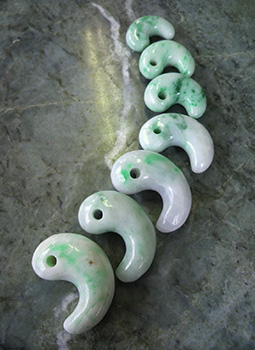
Modern-day jadeite magatama (comma-shaped beads) of the type first produced in Japan in the Yayoi period more than 2,000 years ago 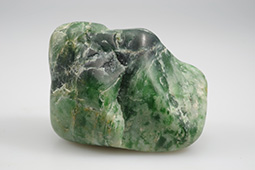
Green jadeite is the best known variety of jadeite in Japan. 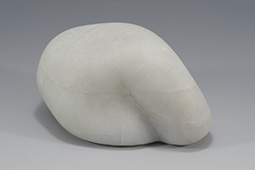
White jadeite 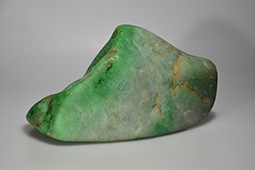
Multi-colored jadeite 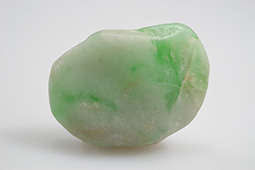
Multi-colored jadeite 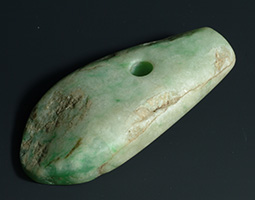
An excavated taishu pendant produced in the Jomon period some 5,000 years ago
October 2021
Jadeite, A Representative Stone of Japan

Jadeite (hisui in Japanese) is a stone that occurs naturally in Japan and has long had a special place in the affections of Japanese people. In September 2016, “jadeite (and jadeitite)”* was selected as the national stone of Japan by the Japan Association of Mineralogical Sciences. We introduce jadeite, its connection to the Japanese people since antiquity and its enduring appeal.

It is thought that jadeite (and jadeitite) forms only in subduction zones, places where two plates on the Earth’s surface overlap. In Japan, the best known variety of jadeite is the slightly transparent green jadeite, which is a valuable gemstone. Besides that, white, lavender, and light blue varieties are also found. The Itoigawa region of Niigata Prefecture is the main production area of jadeite, but the mineral is also quarried in various other parts of Japan.
The history of jadeite processing in Japan dates back to ancient times, and jewelry made of jadeite has been found in early Jomon period ruins dating back 5,000 to 6,000 years. Taishu for example, a type of pendant produced in the Jomon period (which lasted from 10,000 BCE until the start of the Yayoi period), are said to be the first jadeite artifacts ever made by humankind. In addition, many burial necklaces strung with jadeite magatama (comma-shaped beads) have been unearthed. These date from the Yayoi period (10th century BCE to 3rd century CE) and the Kofun period (3rd century to 6th century), indicating that by the end of the Yayoi period jadeite was used in almost every part of Japan. Jadeite would seem to be the first gemstone valued by people living in the Japanese archipelago.

From the Nara period (710–794), Jadeite went from being prized in ancient times to being consigned to obscurity for some 1,200 years. The reason for this is not well understood, but it came under the spotlight again in 1938, when raw jadeite was discovered in the Kotakigawa river in Itoigawa City, Niigata Prefecture. The surrounding locality was found to be the largest source of jade in Japan, and the boulders of jadeite strewn about the riverbeds of the Kotakigawa and Omigawa rivers that run through the area came to be protected as national Natural Monuments. Visitors to the area can observe jadeite in its natural setting, as well as see one of the world’s largest jadeite boulders weighing 102 tons at the Jade Furusato Gallery in Itoigawa City, on the Sea of Japan coast. In August 2009, the Itoigawa Geopark was designated as a UNESCO Global Geopark in recognition of the land’s contribution to “the world’s oldest jade culture.” In September 2016, “jadeite (and jadeitite)” was selected as the national stone by the Japan Association of Mineralogical Sciences (JAMS), an organization dedicated to the advancement and dissemination of the study of mineralogical sciences and related fields.

“In selecting the national stone, our aim was to get more people interested in rocks and minerals,” says Miyawaki Ritsuro, geoscientist and chair of JAMS.
The selection process began with the formation of a working group which established five criteria, including that the national stone should be a beautiful stone that occurs naturally in Japan, have global significance, and be connected to the daily lives of Japanese people. A list of twenty-two candidate stones were selected by the working group and the general public. Then, in 2016, an annual meeting of JAMS was held where the candidates were narrowed down to five: granite, stibnite (antimonite), gold, quartz, and jadeite. Finally, jadeite was selected as the national stone of Japan.

“Jadeite is composed of chemical elements such as sodium, aluminum and silicon. However, the mechanism of its formation has not been fully explained. This mystery may be said to be part of jadeite’s appeal,” says Miyawaki.
Jadeite is a beautiful stone that naturally occurs in Japan and is well known there. Its connection to the Japanese people dates back to ancient times, and it has a profound history of being used to create artifacts. Jadeite’s special place in people’s affections as a representative stone of Japan is sure to continue.
* Rocks that consist mostly of jadeite are called “jadeitite.”



